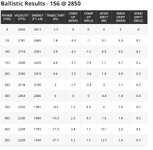After listening to some of
@robby denning points on the Shoot to Hunt podcast regarding steps/time for holdover vs. dial, and consideration of the all the scope evals/proficiency ranges of hunters by
@Formidilosus I started to wonder if holding over is actually more effective in cost and accuracy for the average hunter. Here me out...
- Most hunting scopes cannot dial accurately or return to zero consistently. Hold overs don't change (assuming the reticle is correctly calibrated).
- A lot of engagements are under 400 yards (most far less). With a 100 or 200 yard zero on an "average" cartridge your looking at less than 20-30 inches of drop. Less with a "good" cartridge.
- A mil based reticle with .5 mil increments in holds is fairly intuitive, and out to 400 yards ranges that are not exactly lining up with 200, 300, 400 yards are solved by the trajectory of holding between the .5 mil increments.
- Using something in the 9X upper range like the Trijicon credo in mil square or Swaro Z3 BRH, you will be limited to tighter eye box, and suffer some loss of spotting impact. However, maybe more accurate than dialing a shot using something like a VX3HD CDS?
- Budget is a barrier for many hunters. I am North of the border and SWFA is not an option. The only readily available brand that can dial repeatedly is Nightforce, and many cannot afford to top every rifle they have with one. Plus the reticles kind of suck.
So with a 200 yard zero your holding back out to 300 to keep maximum FOV, and after that you crank up to 9X and use the holds. To Robby's points this seems faster. You range the game, if its in 300 range aim shoot. If outside, crank up scope select hold shoot.
What say you? Would you rather have a scope that is mediocre in adjustments? Or use a holdover with the above considerations?


